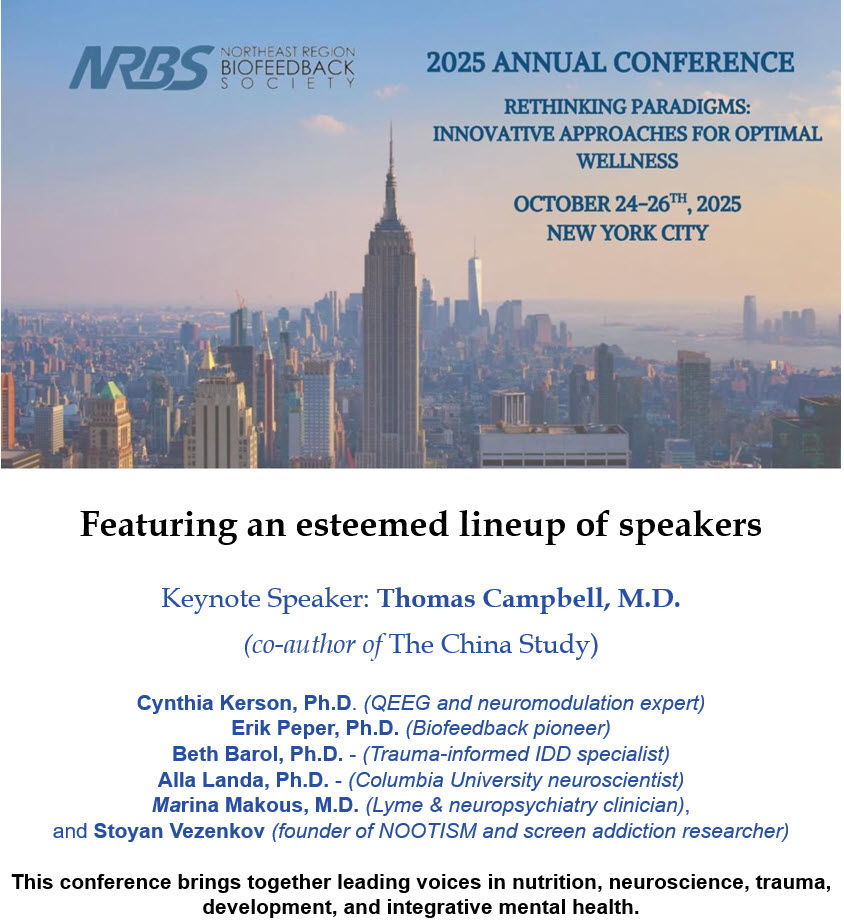"Have We Been Thinking About ADHD All Wrong?" A Response.
- BioSource Faculty
- May 4
- 17 min read
Updated: Aug 1

In the New York Time's "Have We Been Thinking About ADHD All Wrong?" Paul Tough (2025) critically examines prevailing assumptions about Attention Deficit Hyperactivity Disorder (ADHD), highlighting a widening gap between scientific understanding and clinical practice. We review the strengths and limitations of EEG biomarkers, and conclude that several (e.g., event-related potentials and refractory case biomarkers) are promising and shouldn't be summarily dismissed.
Although EEG biomarkers cannot diagnose ADHD, they offer incremental validity over behavioral observation alone.
Increasing ADHD Diagnoses and Concerns about Overdiagnosis
The article details the dramatic increase in ADHD diagnoses over recent decades, prompting significant debate regarding potential overdiagnosis. Central to this discussion is the influential Multimodal Treatment of Attention Deficit Hyperactivity Disorder (MTA) study, which initially indicated significant short-term benefits from stimulant medications but later revealed no long-term advantages compared to non-medicated groups (Swanson et al., 2017).
Critique of ADHD Biomarkers
Tough critiques the traditional medical model of ADHD, which frames the disorder as stemming from inherent biological deficiencies. He claims that although biomarkers such as genetic markers and neuroimaging initially appeared promising, subsequent studies have largely failed to replicate these findings, suggesting a more complex interplay of factors than previously understood (Hoogman et al., 2017).
While diagnosis currently relies on behavioral criteria, researchers have investigated specific EEG patterns that consistently differ between individuals with and without ADHD. Among the most studied are the theta-to-beta power ratio, alpha power characteristics, and specific components of event-related potentials.
Theta-to-Beta Power Ratio
One prominent candidate biomarker is the ratio of theta wave power to beta wave power (TBR). Theta waves (typically 4-7.5 Hz) are associated with drowsiness or idling states, while beta waves (typically 13-30 Hz) are linked to active mental engagement and concentration.
While early studies suggested that TBR could distinguish individuals with ADHD from controls, more recent and comprehensive research has questioned its diagnostic validity and highlighted important limitations.
Diagnostic Validity and Limitations
Initial meta-analyses found that children with ADHD often show elevated TBR compared to controls, with moderate effect sizes. However, these effect sizes have decreased over time, mainly due to rising TBR values in non-ADHD groups, leading to significant overlap between ADHD and control populations. This overlap reduces the sensitivity and specificity of TBR as a diagnostic tool, making it unreliable for clinical diagnosis. Heterogeneity across studies and methodological differences further undermine its diagnostic accuracy, and excessive TBR is now considered an overestimation for ADHD diagnosis (Arns et al., 2013; Boxum et al., 2024; Van Dijk et al., 2020).
Influence of Age, Subtypes, and Comorbidities
The TBR does not consistently differ by ADHD status, especially in youth, and may even be lower in adults with ADHD compared to controls. The ratio is also influenced by ADHD subtypes and psychiatric comorbidities, such as disruptive behavior disorders and depression, which can have opposing effects on TBR values. These mediating factors complicate the interpretation of TBR and limit its generalizability as a biomarker across diverse ADHD populations (Herrera-Morales et al., 2023; Loo et al., 2013).
Technical and Methodological Challenges
Different EEG signal processing methods produce significantly different TBR values, but none reliably distinguish ADHD from healthy controls. The decline in effect size over time is attributed to factors such as participant characteristics and inclusion criteria, rather than EEG processing techniques. The use of fixed EEG frequency bands may also limit the utility of TBR, particularly in youth, and alternative approaches like personalized frequency cut points have been proposed to improve measurement accuracy (Herrera-Morales et al., 2023; Saad et al., 2018).
Subgroup Identification and Prognostic Value
Despite its limitations as a universal diagnostic marker, TBR may have value in identifying specific subgroups within the ADHD population. Studies have confirmed the existence of a high-TBR cluster among ADHD patients, suggesting that TBR could be useful for patient stratification and neuropsychological profiling. However, TBR does not correlate strongly with behavioral traits or ADHD severity, and its main utility may lie in guiding individualized treatment approaches, such as neurofeedback protocols (Arns et al., 2013; Boxum et al., 2024; Bussalb et al., 2019; Herrera-Morales et al., 2023).
Conclusion
Current evidence does not support the use of theta-to-beta ratio as a standalone diagnostic biomarker for ADHD due to limited sensitivity, specificity, and susceptibility to confounding factors. TBR may be useful for identifying subgroups of ADHD patients and informing personalized interventions, but comprehensive clinical evaluation remains essential for accurate diagnosis.
Alpha Power
Alpha power, referring to the magnitude of EEG oscillations in the alpha frequency band (typically 8-12 Hz), has also been explored. Alpha activity is traditionally associated with relaxed wakefulness and cortical inhibition.
Evidence for Alpha Power as a Valid ADHD Biomarker
Alpha oscillations, typically in the 8–12 Hz frequency range, have been extensively studied as potential biomarkers for ADHD due to their role in attention and inhibitory control. The evidence from recent research highlights both the promise and complexity of using alpha power as a diagnostic and prognostic tool for ADHD.
Altered Alpha Power in ADHD
Multiple studies report that individuals with ADHD exhibit distinct patterns of alpha power compared to neurotypical controls. For example, adults with ADHD show attenuated relative alpha power at baseline, suggesting a state of cortical hyperactivation. Notably, interventions such as neurofeedback that target alpha desynchronization can normalize alpha power and are associated with improvements in inhibitory control, as measured by reduced commission errors in Go/NoGo tasks. This normalization of alpha power post-intervention further supports its relevance to ADHD symptomatology and its potential as a biomarker for monitoring treatment response (Deiber et al., 2019).
In children, findings are more nuanced. Some studies have identified subtypes of ADHD characterized by elevated slow or fast alpha power, while others show that increased alpha power may be more prevalent in children with comorbid conditions such as depression, raising questions about specificity. Importantly, these studies emphasize that ADHD is neurophysiologically heterogeneous, and increased alpha power may not be present in all individuals with the disorder (Byeon et al., 2020; Poil et al., 2014).
Alpha Power and Cognitive Function
Alpha modulation during cognitive tasks, particularly working memory encoding, is consistently impaired in ADHD. Children with ADHD demonstrate weaker alpha power decreases during stimulus encoding, which correlates with poorer executive function and reading comprehension. This suggests that deficits in alpha modulation are not only markers of ADHD but also have real-world implications for cognitive and academic performance8. Additionally, aberrant alpha activity during attention tasks is linked to attentional impairments, especially in the inattentive subtype of ADHD, and is associated with task accuracy and reaction time (Lenartowicz et al., 2018).
Developmental and Individual Differences
The relationship between alpha power and ADHD is influenced by age, sex, and individual differences in alpha frequency. For instance, adults with ADHD show a slowing in alpha frequency and higher alpha-1 power, while children with ADHD may exhibit higher alpha power, steeper spectral slopes, and greater offsets in the EEG power spectrum. These findings suggest that alpha power and related spectral features may serve as age-dependent biomarkers, with their diagnostic utility varying across the lifespan (Chen et al., 2024; Poil et al., 2014; Robertson et al., 2019).
Limitations and Considerations
While alpha power shows promise as a biomarker, its specificity to ADHD is not absolute. Some subtypes with increased alpha power may reflect comorbid conditions, and not all individuals with ADHD display the same alpha abnormalities. Furthermore, the diagnostic accuracy of alpha power is higher in adults than in children, and factors such as age, sex, and lateralization must be considered in research and clinical applications (Byeon et al., 2020; Chen et al., 2024; Poil et al., 2014).
Conclusion
Overall, the evidence supports the validity of alpha power as a biomarker for ADHD, particularly in relation to attentional and inhibitory control deficits. However, its utility is moderated by developmental stage, individual differences, and potential overlap with other conditions. Future research should continue to refine the characterization of alpha power abnormalities in ADHD and explore their integration with other neurophysiological and behavioral markers for improved diagnostic precision
Event-Related Potentials
Event-related potentials (ERPs), derived from electroencephalography (EEG), have been extensively studied as potential biomarkers for attention-deficit/hyperactivity disorder (ADHD). The search for objective, brain-based markers is motivated by the limitations of current ADHD diagnostic methods, which rely heavily on subjective behavioral assessments. Several ERP components have shown differences in individuals with ADHD. The P300 component, a positive deflection occurring around 300-600 ms after a relevant stimulus, is often reduced in amplitude in individuals with ADHD during tasks requiring attention allocation and stimulus evaluation (Barry et al., 2003; Groom et al., 2010). This reduction is thought to reflect deficits in attentional resource allocation and context updating.
Similarly, the Contingent Negative Variation (CNV), a slow negative wave preceding an expected stimulus or response, is frequently found to be smaller or less sustained in ADHD, potentially indicating impaired preparatory attention and motor planning (Banaschewski & Brandeis, 2007). ERPs related to error processing, such as the Error-Related Negativity (ERN) and Error Positivity (Pe), may also differ, reflecting altered performance monitoring (Groom et al., 2010).
Diagnostic Differentiation
Multiple studies demonstrate that ERPs can significantly differentiate individuals with ADHD from healthy controls. For example, combining ERP measures with behavioral test scores from a go/no-go task produced a diagnostic index that robustly distinguished children with ADHD from typically developing peers, with large effect sizes. This index also performed well in an independent sample, suggesting reliability and potential clinical utility for supporting ADHD assessment (Häger et al., 2021). Similarly, ERP-based classifiers in the literature have shown sensitivities and specificities ranging from 57% to 96% and 63% to 92%, respectively, in distinguishing ADHD from controls, though methodological inconsistencies across studies remain a challenge (Gamma & Kara, 2020).
ERP Component Differences
Meta-analytic evidence indicates that individuals with ADHD exhibit consistent differences in specific ERP components, particularly in later cognitive ERPs. These include smaller P300 amplitudes, longer P300 latencies, and reduced contingent negative variation (CNV) amplitudes, with moderate effect sizes. Such differences are most pronounced in later ERP components related to cognitive processing, although substantial heterogeneity exists due to demographic and methodological factors4. Other studies confirm that ERP variables, especially those derived from tasks measuring attention and inhibition, can significantly discriminate between ADHD patients and controls, with effect sizes that may reach clinically meaningful thresholds (Ogrim & Kropotov, 2020).
Machine Learning and Classification
Recent advances in machine learning have further supported the potential of ERPs as ADHD biomarkers. Deep learning models trained on ERP-derived EEG spectrograms achieved high classification accuracy (up to 88%) in distinguishing adults with ADHD from healthy individuals. These models identified specific spectral features, such as decreased alpha and increased delta-theta power around 100 ms, that align with known attentional and inhibitory deficits in ADHD (Dubreuil-Vall et al., 2020).
Prognostic and Risk Biomarkers
Beyond diagnosis, ERPs have shown promise as prognostic and risk biomarkers. ERP measures of reward anticipation are associated with ADHD polygenic risk scores and can predict future substance use in adolescents at risk for ADHD, accounting for a significant proportion of variance in outcomes. These findings suggest that ERPs may capture intermediate phenotypes that are more closely linked to underlying neurobiological mechanisms than clinical symptoms alone (Bunford et al., 2024; Hámori et al., 2023).
Clinical Utility and Future Directions
While ERPs reliably capture neurophysiological differences associated with ADHD and show potential for supporting diagnosis and prognosis, their clinical utility is currently limited by heterogeneity in findings, moderate effect sizes, and a lack of standardized protocols (Gamma & Kara, 2020; Kaiser et al., 2020). Machine learning and deep learning approaches may enhance the practical application of ERP biomarkers, but larger, coordinated studies are needed to establish robust, generalizable indices (Dubreuil-Vall et al., 2020; Gamma & Kara, 2020).
Conclusion
In summary, ERPs provide valid and promising biomarkers for ADHD, capable of distinguishing affected individuals from controls and offering prognostic insights, but further research is required to standardize methods and confirm their clinical applicability
Refractory Case Biomarkers
Multiple studies have identified specific electroencephalographic (EEG) biomarkers in ADHD, especially among refractory cases. Four EEG features—focal slowing (FS), spindling excessive beta (SEB), encephalopathy (EN), and isolated epileptiform discharges (IEDs)—have emerged consistently across diagnostic groups, offering insight into treatment resistance and guiding more precise medication strategies (Swatzyna et al., 2014; Swatzyna et al., 2015; Swatzyna et al., 2024).
Focal slowing reflects localized cerebral dysfunction and is often associated with underlying lesions or injuries. In a large cohort of refractory patients, FS was present in over 50% of those with ADHD across all age groups (Swatzyna et al., 2024). This finding underscores the potential structural underpinnings of ADHD in a substantial subset of cases.
Spindling excessive beta (SEB) is defined as frontocentral beta activity with a spindle-like morphology in the 15–35 Hz range. Originally described in epilepsy research, SEB has since been linked to ADHD subtypes marked by impulse control problems (Arns et al., 2015; Krepel et al., 2021). In replication studies, SEB was present in 13–20% of ADHD cases and correlated with increased false positives on continuous performance tasks and higher self-rated impulsivity (Krepel et al., 2021).
Encephalopathy, a diffuse slowing and attenuation of EEG amplitude, is less common in ADHD but still observed in approximately 10–14% of pediatric cases. It typically reflects toxic, metabolic, or hypoxic factors that compromise global brain function (Swatzyna et al., 2024).
Isolated epileptiform discharges (IEDs) have shown the strongest link to ADHD in EEG research. Multiple studies have reported IED prevalence rates ranging from 16% to 35% in ADHD cohorts, compared to <1% in healthy controls (Swatzyna et al., 2017; Swatzyna et al., 2020). These discharges are associated with cortical hyperexcitability and are often subclinical, complicating diagnosis via behavioral observation alone. Their identification has major clinical implications, particularly given that stimulants and antidepressants can lower seizure thresholds (Swatzyna et al., 2024).
While these biomarkers are not unique to ADHD, their identification offers a path to more personalized and biologically informed interventions. Furthermore, these EEG abnormalities are not predictable from DSM-based diagnoses alone. Swatzyna et al. (2015) reported only a 6.25% alignment between formal diagnoses and specific EEG abnormalities in a sample of 386 cases, emphasizing the inadequacy of symptom-only approaches.
EEG Biomarkers in ADHD by Age Group

Caption: The prevalence rates of four EEG biomarkers across children, adolescents, and adults diagnosed with ADHD (Swatzyna et al., 2024).
Evidence for Neurofeedback as an Efficacious Treatment
Compelling evidence from Enriquez-Geppert et al. (2023) further strengthens the case for neurofeedback (NF) as an efficacious and specific treatment for ADHD. Established NF protocols—theta/beta ratio (TBR), sensorimotor rhythm (SMR), and slow cortical potentials (SCP)—have demonstrated significant medium-to-large effect sizes and sustained benefits surpassing medication over time. NF's personalization, based on EEG subtyping, further enhances its efficacy, offering superior clinical effectiveness compared to traditional medication treatments in controlled studies (Enriquez-Geppert et al., 2023).
Risks of Oversimplification
Nevertheless, Tough's critique risks oversimplifying ADHD by dismissing its genuine neurobiological components, particularly in severe cases where environmental adjustments alone prove insufficient. This stance potentially reinforces harmful misconceptions and stigmatizes families reliant on medications. Acknowledging EEG and ERP biomarkers and the efficacy of personalized NF interventions could foster a more nuanced understanding, blending biological and environmental approaches.
Conclusion
Paul Tough’s critique in The New York Times reflects an urgent and evolving discourse surrounding ADHD: how best to reconcile biological complexity with environmental plasticity in understanding, diagnosing, and treating the condition. The evidence reviewed here affirms that while behavioral criteria remain the clinical standard, emerging neurophysiological markers—particularly EEG and ERP signatures—offer substantial promise in identifying ADHD subtypes, predicting treatment responses, and informing personalized interventions. However, these biomarkers vary across age, sex, comorbidities, and cognitive profiles, demanding cautious interpretation and multidimensional integration.
ADHD is not reducible to a singular cause or uniform trajectory. Rather than negating biological underpinnings, evidence supports the convergence of neurobiological and environmental factors across heterogeneous presentations. Importantly, the specificity and efficacy of neurofeedback protocols tailored to EEG subtypes underscore the practical and clinical relevance of these biomarkers. Ultimately, a comprehensive model of ADHD must transcend categorical diagnoses, balancing scientific rigor with empathy, and embracing interventions that span the neural, behavioral, and contextual domains of a child's or adult’s life.
Takeaways
ADHD diagnoses have risen sharply in recent decades, prompting scrutiny over potential overdiagnosis, especially in youth populations subject to evolving educational and behavioral norms.
Long-term data from the MTA study challenge assumptions about medication superiority, revealing that stimulant benefits often wane over time and are not associated with improved long-term academic or cognitive outcomes.
EEG and ERP biomarkers—including TBR, alpha power, and P300—distinguish neurophysiologically defined subgroups within ADHD, offering incremental validity over behavioral observation alone and supporting more individualized assessment strategies.
Refractory ADHD cases exhibit distinct EEG features such as spindling excessive beta, focal slowing, and epileptiform discharges, which correlate with treatment resistance and guide more precise pharmacologic and neuromodulatory interventions.
Personalized neurofeedback, guided by EEG subtyping, is classified as efficacious and specific for ADHD, with demonstrated superiority over medication in sustaining symptom improvement, especially in attention and impulse control.
Tough’s environmentalist framing rightly critiques diagnostic inflation but underestimates the biological heterogeneity underlying ADHD, which, if ignored, risks dismissing those with pronounced neurocognitive impairments.
The most effective ADHD management integrates biological, psychological, and environmental models, thereby reducing stigma, enhancing engagement, and tailoring treatment to each individual’s unique needs.
Glossary
alpha power: EEG frequency band (8–12 Hz) associated with relaxed, alert brain states, often reduced in specific ADHD subgroups.
diffuse slowing: generalized slowing of EEG rhythms indicative of global cortical dysfunction.
error-related negativity (ERN): an event-related potential (ERP) component, specifically a negative deflection in the EEG signal, that occurs shortly after an individual makes an error in a task. It is thought to reflect performance monitoring processes, which may be altered in ADHD.
error positivity (Pe): an event-related potential (ERP) component, typically a positive deflection following the ERN, also associated with error processing and awareness. It may also show differences in individuals with ADHD, reflecting altered performance monitoring.
event-related potentials (ERPs): specific voltage fluctuations in the ongoing EEG signal that are time-locked to the occurrence of a specific sensory, cognitive, or motor event (e.g., stimulus presentation, response execution). They reflect distinct stages of information processing in the brain.
intermittent epileptiform discharges (IEDs): abnormal EEG patterns indicating increased cortical excitability, occasionally observed in ADHD subgroups.
Multimodal Treatment of Attention Deficit Hyperactivity Disorder (MTA): landmark study evaluating medication and behavioral treatments for ADHD.
neurofeedback (NF): a non-invasive treatment using real-time EEG feedback to improve brain function.
P300 component: a specific positive-going event-related potential (ERP) component that typically peaks around 300-600 milliseconds after presenting a relevant or target stimulus, particularly in tasks requiring stimulus discrimination or attention. Its amplitude is often reduced in ADHD, potentially reflecting deficits in attention allocation or context updating.
personalized neurofeedback: NF protocols tailored to individual EEG biomarker profiles to optimize outcomes.
sensorimotor rhythm (SMR): EEG rhythm (12–15 Hz) targeted in NF treatments to enhance focus and reduce hyperactivity.
slow cortical potentials (SCP): slow EEG fluctuations involved in attentional control, trained in specific NF protocols.
spindling excessive beta (SEB): EEG pattern characterized by rhythmic bursts of beta activity, associated with cortical hyperarousal in ADHD.
theta waves: electrical oscillations recorded via EEG within the theta frequency band (typically 4-7.5 Hz). Theta activity is often associated with drowsiness, idling states, or certain types of memory processing.
theta-to-beta ratio (TBR): a quantitative EEG measure calculated by dividing the power of theta waves by the power of beta waves. An elevated TBR has been frequently reported in individuals with ADHD and is interpreted by some as reflecting cortical hypoarousal or underactivation.
References
Aggensteiner, P. M., Brandeis, D., Millenet, S., Hohmann, S., Ruckes, C., Beuth, S., Albrecht, B., Schmitt, G., Schermuly, S., Wörz, S., Gevensleben, H., Freitag, C. M., Banaschewski, T., Rothenberger, A., Strehl, U., & Holtmann, M. (2019). Slow cortical potentials neurofeedback in children with ADHD: comorbidity, self-regulation and clinical outcomes 6 months after treatment in a multicenter randomized controlled trial. European Child & Adolescent Psychiatry, 28(8), 1087–1095. https://doi.org/10.1007/s00787-018-01271-8
Arns, M., Conners, C. K., & Kraemer, H. C. (2013). A decade of EEG theta/beta ratio research in ADHD: A meta-analysis. Journal of Attention Disorders, 17(5), 374–383. https://doi.org/10.1177/1087054712460087
Banaschewski, T., & Brandeis, D. (2007). Annotation: What electrical brain activity tells us about Attention-Deficit/Hyperactivity Disorder (ADHD) – a status report. Journal of Child Psychology and Psychiatry, 48(5), 455–476. https://doi.org/10.1111/j.1469-7610.2006.01681.x
Barry, R. J., Clarke, A. R., Johnstone, S. J., & Brown, C. R. (2009). EEG differences in children between eyes-closed and eyes-open resting conditions. Clinical Neurophysiology, 120(10), 1806–1811. https://doi.org/10.1016/j.clinph.2009.08.006
Boxum, M., Voetterl, H., Van Dijk, H., Gordon, E., deBeus, R., Arnold, L., & Arns, M. (2024). Challenging the diagnostic value of theta/beta ratio: Insights from an EEG subtyping meta-analytical approach in ADHD. Applied Psychophysiology and Biofeedback. https://doi.org/10.1007/s10484-024-09649-y
Bunford, N., Ágrez, K., Hámori, G., Koller, J., Pulay, A., Nemoda, Z., & Réthelyi, J. (2024). Electrophysiological indices of reward anticipation as ADHD risk and prognostic biomarkers. European Child & Adolescent Psychiatry. https://doi.org/10.1007/s00787-024-02606-4
Bussalb, A., Collin, S., Barthélemy, Q., Ojeda, D., Bioulac, S., Blasco-Fontecilla, H., Brandeis, D., Ouakil, D., Ros, T., & Mayaud, L. (2019). Is there a cluster of high theta-beta ratio patients in attention deficit hyperactivity disorder? Clinical Neurophysiology, 130, 1387-1396. https://doi.org/10.1016/j.clinph.2019.02.021
Byeon, J., Choi, T., Won, G., Lee, J., & Kim, J. (2020). A novel quantitative electroencephalography subtype with high alpha power in ADHD: ADHD or misdiagnosed ADHD? PLoS ONE, 15. https://doi.org/10.1371/journal.pone.0242566
Chen, R., Liu, W., Wang, J., Zhou, D., & Wang, Y. (2024). Aperiodic components and aperiodic-adjusted alpha-band oscillations in children with ADHD. Journal of Psychiatric Research, 173, 225-231. https://doi.org/10.1016/j.jpsychires.2024.03.042
Deiber, M., Hasler, R., Colin, J., Dayer, A., Aubry, J., Baggio, S., Perroud, N., & Ros, T. (2019). Linking alpha oscillations, attention and inhibitory control in adult ADHD with EEG neurofeedback. NeuroImage: Clinical, 25. https://doi.org/10.1016/j.nicl.2019.102145
Dubreuil-Vall, L., Ruffini, G., & Camprodon, J. (2020). Deep learning convolutional neural networks discriminate adult ADHD from healthy individuals on the basis of event-related spectral EEG. Frontiers in Neuroscience, 14. https://doi.org/10.3389/fnins.2020.00251
Enriquez-Geppert, S., Brown, T., Henrich, H., Arns, M., & Garcia Pimenta, M. (2023). Treatment efficacy and clinical effectiveness of EEG neurofeedback as a personalized and multimodal treatment in ADHD: A critical review. In I. Khazan, F. Shaffer, D. Moss, R. Lyle, & S. Rosenthal (Eds.). Evidence-Based Practice in Biofeedback and Neurofeedback (4th ed.). Association for Applied Psychophysiology and Biofeedback.
Gamma, A., & Kara, O. (2020). Event-related potentials for diagnosing children and adults with ADHD. Journal of Attention Disorders, 24, 1581 - 1587. https://doi.org/10.1177/1087054716631821
Groom, M. J., Cahill, J. D., Bates, A. T., Jackson, G. M., Calton, T. G., & Liddle, P. F. (2010). Electrophysiological indices of abnormal error-processing in adolescents with Attention Deficit Hyperactivity Disorder (ADHD). Journal of Child Psychology and Psychiatry, 51(1), 66–76. https://doi.org/10.1111/j.1469-7610.2009.02139.x
Häger, L., Åsberg, J., Kropotov, J., Weidle, B., Hollup, S., Zehentbauer, P., Gillberg, C., Billstedt, E., & Ogrim, G. (2021). Biomarker support for ADHD diagnosis based on Event Related Potentials and scores from an attention test. Psychiatry Research, 300. https://doi.org/10.1016/j.psychres.2021.113879
Hámori, G., File, B., Fiáth, R., Pászthy, B., Réthelyi, J., Ulbert, I., & Bunford, N. (2023). Adolescent ADHD and electrophysiological reward responsiveness: A machine learning approach to evaluate classification accuracy and prognosis. Psychiatry Research, 323. https://doi.org/10.1016/j.psychres.2023.115139
Herrera-Morales, W., Reyes-López, J., Tuz-Castellanos, K., Ortegón-Abud, D., Ramírez-Lugo, L., Santiago-Rodríguez, E., & Núñez-Jaramillo, L. (2023). Variations in theta/beta ratio and cognitive performance in subpopulations of subjects with ADHD symptoms: Towards neuropsychological profiling for patient subgrouping. Journal of Personalized Medicine, 13. https://doi.org/10.3390/jpm13091361
Hoogman, M., Bralten, J., Hibar, D. P., Mennes, M., Zwiers, M. P., Schweren, L. S. J., van Hulzen, K. J. E., Medland, S. E., Shumskaya, E., Jahanshad, N., Zeeuw, P., Szekely, E., Sudre, G., Wolfers, T., Onnink, A. M. H., Dammers, J. T., Mostert, J. C., Vives-Gilabert, Y., Kohls, G., Oberwelland, E., … Franke, B. (2017). Subcortical brain volume differences in participants with attention deficit hyperactivity disorder in children and adults: A cross-sectional mega-analysis. The Lancet Psychiatry, 4(4), 310–319. https://doi.org/10.1016/S2215-0366(17)30049-4
Johnstone, S. J., Barry, R. J., & Clarke, A. R. (2013). Ten years on: A follow-up review of ERP research in attention-deficit/hyperactivity disorder. Clinical Neurophysiology, 124(4), 644–657. https://doi.org/10.1016/j.clinph.2012.09.006
Kaiser, A., Aggensteiner, P., Baumeister, S., Holz, N., Banaschewski, T., & Brandeis, D. (2020). Earlier versus later cognitive event-related potentials (ERPs) in attention-deficit/hyperactivity disorder (ADHD): A meta-analysis. Neuroscience & Biobehavioral Reviews, 112, 117-134. https://doi.org/10.1016/j.neubiorev.2020.01.019 Krepel, N., van Dijk, H., Sack, A. T., Swatzyna, R. J., & Arns, M. (2021). To spindle or not to spindle: A replication study into spindling excessive beta as a transdiagnostic EEG feature associated with impulse control. Biological Psychology, 165, 108188. https://doi.org/10.1016/j.biopsycho.2021.108188 Lenartowicz, A., & Loo, S. K. (2014). Use of EEG to diagnose ADHD. Current Psychiatry Reports, 16(11), 498. https://doi.org/10.1007/s11920-014-0498-0
Lenartowicz, A., Mazaheri, A., Jensen, O., & Loo, S. (2018). Aberrant modulation of brain oscillatory activity and attentional impairment in Attention-Deficit/Hyperactivity Disorder. Biological Psychiatry. Cognitive Neuroscience and Neuroimaging, 3(1), 19-29. https://doi.org/10.1016/j.bpsc.2017.09.009
Loo, S. K., Lenartowicz, A., & Makeig, S. (2013). Research review: Use of electroencephalography to subtype attention-deficit/hyperactivity disorder. Journal of Child Psychology and Psychiatry, 54(9), 937–950. https://doi.org/10.1111/jcpp.12058 Ogrim, G., & Kropotov, J. (2020). Event related potentials (ERPs) and other EEG based methods for extracting biomarkers of brain dysfunction: Examples from pediatric Attention Deficit/Hyperactivity Disorder (ADHD). Journal of Visualized Experiments: JoVE, 157. https://doi.org/10.3791/60710
Poil, S., Poil, S., Bollmann, S., Ghisleni, C., Ghisleni, C., O'Gorman, R., O'Gorman, R., Klaver, P., Ball, J., Eich-Höchli, D., Brandeis, D., & Michels, L. (2014). Age dependent electroencephalographic changes in attention-deficit/hyperactivity disorder (ADHD). Clinical Neurophysiology, 125, 1626-1638. https://doi.org/10.1016/j.clinph.2013.12.118
Robertson, M., Furlong, S., Voytek, B., Donoghue, T., Boettiger, C., & Sheridan, M. (2019). EEG power spectral slope differs by ADHD status and stimulant medication exposure in early childhood. Journal of Neurophysiology. https://doi.org/10.1152/jn.00388.2019
Saad, J., Kohn, M., Clarke, S., Lagopoulos, J., & Hermens, D. (2018). Is the theta/beta EEG marker for ADHD inherently flawed? Journal of Attention Disorders, 22, 815 - 826. https://doi.org/10.1177/1087054715578270
Swanson, J. M., Arnold, L. E., Molina, B. S. G., Sibley, M. H., Hechtman, L. T., Hinshaw, S. P., ... & Wigal, T. (2017). Young adult outcomes in the follow-up of the multimodal treatment study of attention-deficit/hyperactivity disorder: Symptom persistence, source discrepancy, and height suppression. Journal of Child Psychology and Psychiatry, 58(6), 663–678. https://doi.org/10.1111/jcpp.12684
Swatzyna, R. J., Tarnow, J. D., Roark, A., & Mardick, J. (2017). The utility of EEG in attention deficit hyperactivity disorder: A replication study. Clinical EEG and Neuroscience, 48(4), 243–245. https://doi.org/10.1177/1550059416640441
Swatzyna, R. J., Arns, M., Tarnow, J. D., Turner, R. P., Barr, E., MacInerney, E. K., Hoffman, A. M., & Boutros, N. N. (2020). Isolated epileptiform activity in children and adolescents: Prevalence, relevance, and implications for treatment. European Child & Adolescent Psychiatry. https://doi.org/10.1007/s00787-020-01597-2
Swatzyna, R. J., Morrow, L. M., Collins, D. M., Barr, E. A., Roark, A. J., & Turner, R. P. (2024). Evidentiary significance of routine EEG in refractory cases: A paradigm shift in psychiatry. Clinical EEG and Neuroscience. https://doi.org/10.1177/15500594231221313
Swatzyna, R. J., Tarnow, J. D., Tannous, J. D., Pillai, V., Schieszler, C., & Kozlowski, G. P. (2015). EEG/QEEG technology identifies neurobiomarkers critical to medication selection and treatment in refractory cases. Clinical EEG and Neuroscience, 46(3), 192–196. https://doi.org/10.1177/1550059414556120
Tough, P. (2025). Have We Been Thinking About ADHD All Wrong? The New York Times Magazine.
Van Dijk, H., deBeus, R., Kerson, C., Roley‐Roberts, M., Monastra, V., Arnold, L., Pan, X., & Arns, M. (2020). Different spectral analysis methods for the theta/beta ratio calculate different ratios but do not distinguish ADHD from controls. Applied Psychophysiology and Biofeedback, 45, 165 - 173. https://doi.org/10.1007/s10484-020-09471-2

We have added Michael McKee, Anu Kotay, and Christine Sanchez to our Biofeedback Gallery and Brendan Parsons to our Neurofeedback Gallery. We have added a PDF of this post at its end.
Support Our Friends











Comments